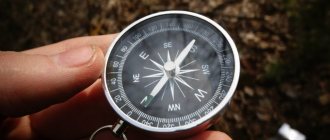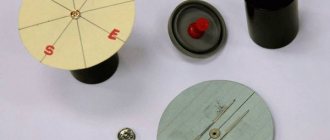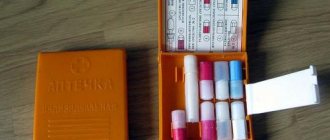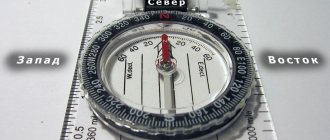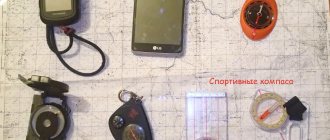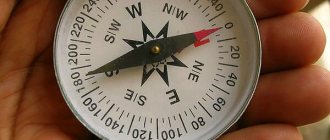Analog vs Digital Navigation Devices
In the modern world, which is flooded with all kinds of devices and gadgets, tourists often prefer an electronic GPS navigator instead of a paper map and compass, completely forgetting that the socket for charging the battery is left at home, and the satellite signal may disappear at the right time. An accurate and up-to-date topographic map, coupled with a compass, are still the primary navigation tools when traversing wilderness areas.
Moreover, special competitions are held in the so-called orienteering, where participants demonstrate their ability to plot a route and follow it accurately using only a map and compass.
Types of compasses
First of all, compasses are either electronic or magnetic.
Electronic ones include: radio compasses (landmark – any source of radio waves), electronic tourist compasses (landmark – the magnetic fields of our planet, the direction of which is determined by sensors on microcircuits) and GPS/GLONASS navigators (landmark – signals and position of orbiting satellites). These are the most accurate and most modern tools for determining the position of an object in space.
Representatives of the next group - magnetic compasses - have been used by humans for many millennia. For the first time, a product made of magnetic iron ore, precisely pointing one end to the South and the other to the North, was invented in China more than two thousand years ago and was called “synan” - “in charge of the South”.
Magnetic ones include tourist (including Andrianov's compass), military, geological, gyroscopic, astronomical and compass compasses. They all operate on the same principle, are built according to similar schemes and differ only in some additions that make one or another type unique and determine the scope of application of this device.
A typical representative of its group is Andrianov's compass. Invented back in the last century, this navigation tool is still actively used by tourists all over the planet.
Andrianov's compass (photo, history of creation)
In 1907, a talented Russian engineer and military cartographer, Vladimir Nikolaevich Adrianov, presented the first military compass to the command. Simplicity of design, reliability and accuracy brought the invention unprecedented popularity. In honor of the author, the device was named Adrianov's compass. In subsequent years, right up to our time, the name of the inventor was often distorted by adding the letter “n”. Thus, one of the most popular traveler’s instruments received an additional, colloquial name “Andrian’s compass.”

Compass design and operating principle
The design of Andrianov's compass has not undergone fundamental changes over the last century. This magnetic compass, which according to modern classification has been transferred to the tourist group, works on the principle of interaction of fields created by a permanent magnet with the magnetic fields of our planet.
This instrument is a durable round case, covered with transparent glass, inside which a magnetic needle rotates on a needle, the ends of which are marked in different colors - red and blue. The edging of the case is made in the form of a dial and is complemented by a rotating ring on which two visors are located. The device is equipped with a leather strap with wristwatch-style clasps. In the side of the case there is a mechanism for fixing the arrow - a latch.
Andrian's compass has an internal chamber filled with air. In modern compasses, instead of air, a non-freezing liquid is used, which creates a viscous medium, which makes the needle movements smooth and inert.
Advantages and disadvantages of the device in operation
Adrianov's compass (like any other magnetic one) allows you to determine the cardinal directions, orient the map, measure azimuths to objects, and also choose a direction based on a known azimuth. The procedure for working with it is no different from working with other tourist compasses.

The strap and the ability to attach the compass to your hand at one time became the main advantage of the device over other models.
However, like other models, this compass has its advantages and disadvantages.
Its advantages include:
- Compactness. Compared to tablet compasses, this one is significantly smaller in size, which allows it to be worn comfortably on the wrist, like a wristwatch.
- Reliability. Unlike liquid compasses, this device will work even after the flask is damaged: it is not afraid of air trapped under the flask, which can lead to malfunctions of liquid devices.
- Ability to work in the dark. Thanks to the luminous paint that marks some elements of the device, you can work with it even at night.
Now let's talk about the disadvantages. And they are as follows on Adrianov’s compass:
- Pointer instability. Compared to liquid compasses, when working with instruments whose bulb is not filled with liquid, the needle is almost constantly in motion, which, firstly, reduces the speed of working with the device (you need to wait for the needle to calm down), and secondly, reduces the accuracy measurements (if the device is on the wrist, the arrow still continues to oscillate).
- Difficulty working with a topographic map. Due to the lack of a ruler, which is equipped with an artillery compass and tablet models, measurements when working with maps are less accurate, and it is not so convenient to work with them.
- The fading glow of the elements. The luminous paint used in the modern Adrianov compass works on the “received-gave” principle, that is, in order for the elements to glow, they must first be “charged” by holding them in the light. Models that use tritium backlight in their design do not have this drawback. We talked about this in a separate article (How to determine azimuth by...).
In addition to the disadvantages described, Adrianov’s compass has one more, which I would like to pay special attention to.
Basic principles of orientation
Before you start using a compass, you need to understand some theoretical basics.

Navigation traditionally uses four main directions: North, South, West, East. To more accurately determine the direction of movement, the concept of “azimuth” was introduced.
Azimuth is the amount of angle, measured in degrees, clockwise from North to a given direction. In order to move from the current position to the final destination (point) of the route, the tourist must know the azimuth and distance to the point, and also determine the position of the North. The first two values must be known in advance or can be determined from the map, and a compass will help you find the North.
Purpose, device of Adrianov's compass.
Adrianov's compass is designed to determine directions to the sides of the horizon and measure horizontal angles.
It consists of:
— a housing with an axis fixed to it;
— magnetic needle;
- dial (circular scale);
— brake lever;
— a rotating cover with a sighting device.
The circular scale (limb) is divided into 120 divisions, the value of the dial division, i.e. the number of degrees (thousandths) corresponding to one division is 30 (50 thousandths). The count of degree divisions increases clockwise, and in thousandths - in the opposite direction. The divisions are signed: in degrees - after 150, and in thousandths - after 500 thousandths (5-00). The sighting device consists of a rear sight and a front sight; it allows you to take readings on a compass scale and sight objects on the ground.
The reading on the dial is taken against the pointer mounted on the inner wall of the cover opposite the front sight.
The northern end of the magnetic needle, the reading and division indicators on the dial, corresponding to 0, 90, 180, 2700, are covered with glow-in-the-dark paint, which makes it easier to use the compass at night.
Magnetic azimuth.
Magnetic azimuth is a horizontal angle measured clockwise (from 00 to 3600) from the north direction of the magnetic meridian (compass needle) to the direction of a specific object.
Scale, types of scales.
MAP SCALE is the degree to which the lines on the map are reduced relative to the horizontal locations of their corresponding lines on the ground.
That is. SCALE is the ratio of the length of a line on a map (plan) to the length of the corresponding line on the ground.
The scale can be expressed numerically or graphically (as a graph).
Depending on this, there are the following types of scale:
— numerical;
— linear;
- transverse.
4. Methods for determining directions to the sides of the horizon.
Methods for determining the direction to the sides of the horizon
- by compass;
- according to the heavenly bodies;
- based on the characteristics of local objects.
Checking the compass.
The compass with the brake released is placed horizontally on the ground, stump, table, etc. After the arrow has calmed down, it is thrown out of balance several times by bringing some steel or iron object to it. If, after each shift, the arrow quickly establishes its ends at the same readings along the dial, then this means that it is quite sensitive. Receiving different readings or the arrow returning too slowly to its previous position indicates that the sensitivity of the arrow is insufficient: either the needle tip has become dull and needs to be sharpened, or the arrow head is faulty (dirt has entered, there are scratches), or the arrow is weakly magnetized and the compass needs under repair.
In order to protect the needle point from rapid wear, the compass needle should be in a locked position when carrying and storing it. To charge the luminous parts of the compass so that they are better visible in the dark, the device should be kept open for 15-20 minutes in a bright electric light.
You should avoid working with the compass during a thunderstorm, as well as near steel and iron objects, as they affect the accuracy of the magnetic needle readings.
Determining directions to the sides of the horizon.
Place the compass in a horizontal position. Rotate the sighting position so that the slot is set to 1800 i.e. south, and with the front sight - at 00 i.e. north.
Release the brake of the magnetic needle and, by rotating the compass, achieve a position so that the magnetic needle with its upper end points to 00 - north, bring the compass to eye level and notice a landmark (target) in this direction, which will indicate the direction north. The remaining sides of the horizon are respectively: east - 900, south 1800, west 2700.
According to the position of the Sun:
At mid latitudes the Sun is located:
- at 7.00 - in the east;
- at 13.00 - in the south;
- at 19.00 - in the west.
The average movement of the Sun during an hour is 150.
In the Northern Hemisphere, the Sun rises in the summer approximately in the northeast and sets in the northwest, and in the winter in the southeast and southwest, respectively. Only on March 21 and September 23 (equinox) does the Sun rise accurately in the east and set in the west.
According to the Sun and hours:
- give the clock a horizontal position;
- install them so that the hour hand is pointed at the Sun, while the straight line dividing the angle between the hour hand and the number “1” (in summer, the number “2”) on the dial will indicate the direction to the south.
The angle is divided because the Sun makes an apparent journey around the Earth in 24 hours. During this time, the hour hand circles the dial twice, so the angle bisector shows the direction in which the luminary should be at noon, i.e. direction south.
The North Star is always in the north. Find the constellation Ursa Major in a cloudless sky. Through the two outermost stars of the Big Dipper you need to mentally draw a straight line and put 5 segments on it equal to the distance between the outermost stars. The end of the fifth segment will indicate the location of the North Star, which is located in the constellation Ursa Minor (the final star of the “small bucket”).
The North Star can serve as a reliable guide for maintaining the direction of movement, since its position in the sky practically does not change over time. The accuracy of determining the direction according to the North Star is 2-3 degrees.
Based on local items:
This method is less reliable than those discussed earlier, therefore, when determining directions to the sides of the horizon, it is necessary to use several signs.
Many signs are determined by the location of local objects in relation to the Sun:
- mosses and lichens on the bark of trees, on large stones, rocks, old wooden ones are concentrated mainly on the north side;
- the bark of a tree is usually rougher and darker on the northern side than on the southern side (this is especially noticeable on birch);
— in the hot season, more resin is released on the trunks of coniferous trees on the south side;
— in spring, on the northern outskirts of forest glades, the grass is thicker than on the southern ones; near individual trees, trunks, large stones, the grass grows thicker on the south side;
- anthills, as a rule, are located to the south of the nearest trees and stumps, their southern side is flatter than the northern;
— the snow quickly melts on the southern slopes, resulting in jagged formations that show the direction to the south;
— clearings in the forest are usually oriented in the north-south or west-east direction;
— the numbering of blocks in forested areas in the Russian Federation goes from west to east and further to the south;
— the altars of Orthodox churches, chapels and Lutheran kirks face east, and the main entrances are located on the west side;
— the altars of Catholic churches (cathedrals) face west;
— the raised end of the lower crossbar of the cross faces north;
- shrines (pagan chapels with idols) face south.
Practical application of Adrianov's compass
Before you start your journey, you need to remember how to use Andrianov’s compass. First you need to pull out the lock, thereby releasing the magnetic needle of the device. Then you need to position the compass in a horizontal plane. After several rotations, the arrow will slowly stop and its blue end will point to the North. Next, you need to rotate the device body until the blue arrow mark points to the dial mark “C”. Thus, we have determined the main cardinal directions: “N” - North, “S” - South, “W” - West, “E” - East.
Now it's time to determine the azimuth. First, let's determine the price of division of the dial scale of our compass. The entire circle is 360 degrees. You need to find nearby labels with numbers and subtract the smaller number from the larger number. The result must be divided by the number of divisions (segments) between the numbers. For example: the dial has the values 15 and 30, with 3 segments (divisions) between them. The price of one division is (30-15)/3=5 degrees.
Now from the zero point (“C”, North) clockwise we set off the required azimuth by rotating the ring with the sights. For example, to set an azimuth of 75 degrees, you need to rotate the ring from the zero mark 15 divisions clockwise.
We check the position of the arrow; it should still point to “C” with a blue mark. Now, looking through the slits of the sights as if through a sight, we know exactly the direction of movement at a given azimuth.

Adrianov's compass has been and will be the most reliable and accessible tool for any traveler. By improving your navigation skills using a map and compass, you can confidently navigate the wilderness without the risk of getting lost.
How does Adrianov's compass work?
The extremely simple design of Adrianov's compass explains its active use for many years. Despite the fact that more modern and accurate models have recently appeared (for example, satellite compasses or GPS navigators), in certain conditions this simple device can become truly indispensable (Figure 1).
The design of the compass consists of only a few elements: a plastic case, a magnetic needle and a strap. However, these are only the basic structural elements. In fact, the device is a little more complicated.
A simple Adrianov compass, which can be worn on a strap, has the following features:
- On the body there is an annular dial (scale), external and internal. The outer dial is marked in thousandths and is divided into 12 equal segments, with the markings located counterclockwise. The internal scale has 120 divisions (in degrees).
- Also installed in the body are the rear sight and front sight, which can rotate freely, making it easier to determine the location of the object.
- The compass is additionally equipped with a lock - a special mechanical lever that holds the arrow stationary.

The ends of the arrow are colored blue and red. In this case, blue usually points to the north, and red - to the south. In some modern models, marks are applied to the body with glow-in-the-dark paint, although initially such a coating was quite common.
In the entire history of the existence of such a compass, there has not been a single case when a working device did not help to navigate in space. Therefore, if you travel often or simply like to spend time outdoors, this device should definitely be part of your equipment.
